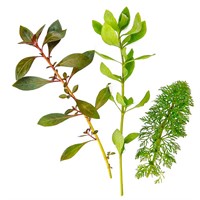Copyright: The following article has been originally published on the Dennerle Plants homepage: Morphology of plants.

The morphology of plants (their visible form,is a fascinating topic for both botany fanatics and laymen alike. The variety of forms that exist on our planet is a wonder to be marveled at, even within the confine of one’s own four walls.
Aquarium plants can vary significantly in shape and growth. Comparative morphology therefore divides the diversity of forms into certain basic patterns, which then lead to a specific classification.
We have described eight different groups with typical growth forms and growth behavior for you. Thus, you can easily choose your “favorites" and of course combine them.
|
Stem plants The vegetation body of a plant is divided into 3 basic organs - shoot axis, leaf and root. Typical for stem plants is the elongated shoot axis with varying distances between the leaf attachments. The distance from one leaf attachment (nodus) to the next is called the internode. These vary in length depending on the species and sometimes give clues to the condition of a plant. Leaf position can vary greatly. There are alternate, opposite, whorled, and many more leaf positions. These compose the appearance of a plant. Stem plants always grow at the tip of the shoot (the vegetation cone). Stem plants are usually fast growing and therefore need regular pruning. Many genera and species like Hygrophila or Alternanthera have the tendency to grow above the water level. Here, the typical above-water form (emers) is found. This form often differs from the underwater form (submers). |
|
Reading tip: Plants changing from emers to submers

 |
Rosette plants In a rosette plant, the shoot axis is strongly compressed and the leaves are arranged in basal rosettes. The new leaves always appear near the ground at the base of the rosette. The growth habit of the leaves is usually simple oblong or elliptical. Echinodorus and Cryptocoryne are typical representatives of a rosette plant. If the plant has grown too large, it should be completely cut back a few centimeters above the substrate. New leaves will then quickly form again from the center - these are referred to as "heart leaves". |

|
Stoloniferous plants These are primarily rosette plants with a propagation strategy via stolon shoots. In botany, these are referred to as stolons. They are found either underground in the substrate, as demonstrated by the popular Vallisneria, or above-ground, as seen in Lilaeopsis. Young plantlets develop from the small axillary buds of the stolon shoots, and the plant population in the aquarium becomes denser and denser. The formation of stolons is rather atypical for stem plants, but is observed very well in Hygrophila pinnatifida. Small stolon shoots form directly at the root neck to find a place to grow elsewhere. |
|
Reading tip: Hygrophila pinnatifida natural habitat in India

 |
Rhizome Plants Rhizomes have a root-like appearance, but are thickened shoot axes. They are used for vegetative reproduction as well as storage of reserve materials such as starch or inulin. Rhizome formation is particularly pronounced in the genus Anubias and Bucephalandra. The thickness of the rhizome can sometimes be up to 3 cm and have an enormous, wood-like strength. In nature, these plants grow creeping over rocks, stones, and roots. They provide a clear indication of the culture and care of an aquarium. The fern plants Microsorum and Bolbitis, are also representatives of the rhizome plants. |

|
Plants with tubers A plant tuber is a transformed shoot axis with a fleshy and thickened structure. Here, nutrients are stored for enduring unfavorable living conditions such as drought. Usually the storage function is only sufficient for one growing season. When the supply is depleated, a new tuber is formed. Aponogeton species and the popular Tiger lotus (Nymphaea lotus), are the best known plants with tuber formation in aquaristics. The shape of the tubers are species-specific and range from ovoid, elongated, or flat-roundish (Aponogeton boivinianus). |
|

 |
Plants with bulbs The bulb is also a storage organ for surviving a dormant or dry period. The highly compressed shoot axis is encased in fleshy bracts called bulbils. Nutrients are collected in the onion disc which is located at the base of the bulb, where the roots also emerge. The genus Crinum has the same growth habit as an an onion. The bulbs of Crinum calamistratum are rather thin and elongated, as observed in Crinum thaianum. The shape is very similar to our edible onions. |

|
Mosses Mosses are a very old plant group in the history of the earth. They significantly influenced the development of land plants. Mosses consist of a network of moss stems with many moss leaflets attached to them. With root-like adhesion organs (rhizoids), mosses can anchor themselves to various substrates. Water and nutrients are absorbed over the entire surface of the moss cushions. Mosses are usually very filigree and delicate. Species recognition within a genus, as with Taxiphyllum, is a challenge for the moss specialist. |
|

 |
Floating plants Floating plants are free-floating plants that exist on the water surface. Depending on the genus and species, they may have special swimming organs as an optimal adaptation. Usually it is spongy tissue with distinct cavities. Some examples include the floating leaves in Salvinia species, or the thickened, air-filled petioles in Trapa natans. Limnobium species, on the other hand, have a spongy leaf underside. Another special feature is their protection against wetness by means of strong pubescence or bulging of the floating leaves, so that rainwater can quickly drain off. |
Check out more floating plants in our plant database.





